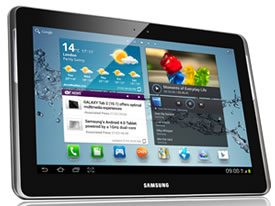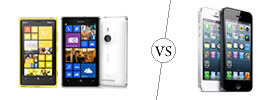Difference between Samsung Galaxy Tab 2 10.1 and iPad
Key Difference: The Galaxy Tab 2 10.1 is a 10.1-inch tablet that was launched in May 2012. The tablets sports a Plane Line Switching (PLS) TFT capacitive touchscreen with approximately 149 ppi density, making the resolution on the screen not that great. The Wi-Fi model is powered by 1 GHz Dual-core Cortex-A9, while the Wi-Fi + Mobile model is powered by 1.5GHz, Dual-core Krait Qualcomm processor. iPads have the screen size of 9.7 inches with multi-touch display. iPads are intended as devices for a multimedia experience, reading e-books, watching movies, listening to music, playing games, browsing the Internet, or retrieving e-mail.
 Following the launch of the Samsung Galaxy Tab 2 7.0, Samsung also needed a tablet for competing in the 10-inch tablet market. Lo and behold it launched the Samsung Galaxy Tab 2 10.1, which shares many similarities to its little brother. Similar to the Tab 2 7.0, the company launched two models of the Tab 2 10.1: Wi-Fi only and Wi-Fi + Mobile. The Wi-Fi and Wi-Fi + Mobile are quite identical in looks and also have similar hardware under the hood. The only differences between the two are the processor speed, OS and the camera features. The two different models allow the consumer to have the choice of either having only Wi-Fi or Wi-Fi + Mobile capabilities and pay accordingly.
Following the launch of the Samsung Galaxy Tab 2 7.0, Samsung also needed a tablet for competing in the 10-inch tablet market. Lo and behold it launched the Samsung Galaxy Tab 2 10.1, which shares many similarities to its little brother. Similar to the Tab 2 7.0, the company launched two models of the Tab 2 10.1: Wi-Fi only and Wi-Fi + Mobile. The Wi-Fi and Wi-Fi + Mobile are quite identical in looks and also have similar hardware under the hood. The only differences between the two are the processor speed, OS and the camera features. The two different models allow the consumer to have the choice of either having only Wi-Fi or Wi-Fi + Mobile capabilities and pay accordingly.
The Galaxy Tab 2 10.1 is a 10.1-inch tablet that was launched in May 2012. According to many review websites, the tablet has been a bit of a letdown compared to the original Tab 10.1. The company has completely shifted the focus of the tab and has even downgraded some of the features. To some it is worth the price, while the others are willing to shell out a little extra if the features are up to mark. The company has managed to keep the slim and sleek design of the device, which is one of the many good features of the Tab. The chassis is plastic and is available in brushed Titanium Grey, giving it a metal look. The speakers have been moved to the front of the screen and placed between the bezel and the chassis, making it seem like the tablet has ‘ears’. This also takes away from the fluidity of the bezel of the screen.
The tablets sports a Plane Line Switching (PLS) TFT capacitive touchscreen with approximately 149 ppi density, making the resolution on the screen not that great. The company has managed to put excellent viewing angles on the device but it still has a lot of reflective ability, making it harder to work under direct sunlight. The Wi-Fi model is powered by 1 GHz Dual-core Cortex-A9, while the Wi-Fi + Mobile model is powered by 1.5GHz, Dual-core Krait Qualcomm processor. Both the models offer 1 GB RAM. The device is a bit jerky in responding and is a little slow when switching between home screens. The Wi-Fi model comes with Android 4.0 Ice Cream Sandwich, while the Wi-Fi + Mobile comes with Android 4.1 Jelly Bean, but fear not the Wi-Fi model is upgradable to v4.1. Samsung has also added a screenshot button to the soft buttons at the bottom of the screen.
When in landscape mode, the device houses five features on the top of the device: a volume rocker, microSD slot, power/sleep button, an IR blaster, and a headphone jack. The camera sans flash resides on the back, while a dock connector and microphone pinhole are at the bottom of the device. The device offers a 3MP rear camera and a VGA camera for video calling. The rear camera offers decent images, though they images may be grainy when not taken in adequate lighting. The Wi-Fi model offers various camera features such as: Shot Modes
Effects, ISO, Scene mode, Shooting mode, White balance, Camcorder, HD Recording and
HD Playback. The device also has video taking capability. The tablet is available with 16/32 GB internal storage capacity that is upgradable by 32GB. The Galaxy Tab 2 10.1 houses a powerful non-removable Li-Po 7000 mAh battery, providing a good battery life compared to many other tablets. The device comes with already loaded Samsung apps, while other apps can be downloaded from the Google Play.
 Apple originally launched iPad in 2010. Its launch started a new trend for tablets. iPad is a type of tablet PC, which was originally promoted as a cross between an Apple iPhone and iPod Touch with added capabilities of computing. However, it is not meant to be a replacement for desktop personal computers or laptops. iPads have computational properties that can do some tasks as laptops but not all.
Apple originally launched iPad in 2010. Its launch started a new trend for tablets. iPad is a type of tablet PC, which was originally promoted as a cross between an Apple iPhone and iPod Touch with added capabilities of computing. However, it is not meant to be a replacement for desktop personal computers or laptops. iPads have computational properties that can do some tasks as laptops but not all.
iPads have the screen size of 9.7 inches with multi-touch display, that provides approximately 264 pp density. The screen has a scratch-resistant glass and an oleophobic coating that keeps fingerprints on the screen and the back. iPads are intended as devices for a multimedia experience, reading e-books, watching movies, listening to music, playing games, browsing the Internet, or retrieving e-mail. It has a software structure more like that of a mobile phone. It also has a very simple user interface, which can even be easily operated by children. iPads are available with a memory capacity of 16 GB, 32 GB, 64 GB and 128 GB.
The device runs on 1.4 GHz dual-core processor and has a 1GB RAM. The iPad has been called the best iPad of all the four generations. The iPad is powered by the new Apple A6X chipset. The device has a 5MP rear camera for taking photos and a 1.2MP front camera for video calling capability. The camera also has video recording capability and can record 1080p@30fps and has video stabilization. The iPad has a 42.5-watt non-removable lithium-polymer battery. The iPad is available in models supporting only Wi-Fi, or 3G and Wi-Fi. However, iPad lacks Flash, software that a number of websites use to display content. So, iPad cannot load these pages. This limits the web surfing experience. The fourth-gen iPad is similar to its predecessors, while it still has two minor and one major upgrade on it. The 30-pin connector has been upgraded to a smaller Lightning connector, while the front camera has been upgraded to the HD Status. The major upgrade is the new A6X processor that replaced the A5X processor on the third-gen.
The information for the detailed table about the two phones has been taken from the Samsung website, expertreviews.co.uk, Apple website and GSMArena.com.
|
|
Samsung Galaxy Tab 2 10.1 |
iPad (4th generation) |
|
Launch Date |
May 2012 |
November 2012 |
|
Company |
Samsung |
Apple |
|
Size |
256.6 x 175.3 x 9.7 mm |
241.2 x 185.7 x 9.4 mm (9.50 x 7.31 x 0.37 in) |
|
Display |
10.1-inch PLS TFT capacitive touchscreen |
9.7 inches LED-backlit IPS LCD, capacitive touchscreen, 16M colors |
|
Screen |
800 x 1280 pixels (~149 ppi pixel density) |
1536 x 2048 pixels, (~264 ppi pixel density) |
|
Protection |
Corning Gorilla Glass |
Scratch-resistant glass, oleophobic coating |
|
Weight |
581 grams (Wi-Fi only) and 583 (Wi-Fi + Mobile) |
652g (1.44 lb) 662g (1.46 lb) for 3G model |
|
2G Network |
GSM 850 / 900 / 1800 / 1900 |
(Wi-Fi + Cellular Model) GSM 850 / 900 / 1800 / 1900 - A1459/ A1460 (Wi-Fi + Cellular Model) CDMA 800 / 1900 / 2100 - A1460 |
|
3G Network |
HSDPA 850 / 900 / 1900 / 2100 |
(Wi-Fi + Cellular Model) HSDPA 850 / 900 / 1900 / 2100 - A1459/ A1460 (Wi-Fi + Cellular Model) CDMA2000 1xEV-DO - A1460 |
|
4G Network |
LTE Dual-band:17 and 4 |
(Wi-Fi + Cellular Model) LTE 700 MHz Class 17 / 1700 / 2100 - A1459 (Wi-Fi + Cellular Model) LTE 700 / 850 / 1800 / 1900 / 2100 - A1460 |
|
GUI |
TouchWiz UX UI |
iUI |
|
CPU speed |
1 GHz Dual-core Cortex-A9 (Wi-Fi only)1.5GHz, Dual-core Krait, Qualcomm (Wi-Fi + Mobile) |
Dual-core 1.4 GHz |
|
GPU |
PowerVR SGX540 |
PowerVR SGX554MP4 (quad-core graphics) |
|
OS |
Android v4.0 (Wi-Fi) and Android v4.1 (Wi-Fi + Mobile) |
iOS 6 |
|
Chipset |
TI OMAP 4430 |
Apple A6X |
|
RAM |
1 GB RAM |
1 GB |
|
SIM Size |
mini-SIM |
Micro-SIM for 3G model |
|
Internal Memory |
16/32 GB |
16/32/64/128 GB |
|
Expandable Memory |
Upgradable to 32 GB |
None |
|
Sensors |
Accelerometer, light, compass |
Accelerometer, Gyroscope, compass |
|
Connectivity |
EDGE, GPRS, LTE, Bluetooth, Wi-Fi and USB. |
Wi-Fi + Cellular Model
Wi-Fi + Cellular Model (MM)
Data only All Models 802.11a/b/g/n Wi-Fi (802.11n 2.4GHz and 5GHz) Bluetooth 4.0 wireless technology |
|
Data |
GPRS, EDGE, WLAN, Bluetooth, USB, USB Host, Wi-Fi Hotspot. |
WiFi, USB GPRS, EDGE, LTE for Wi-Fi + Cellular Model |
|
Speed |
HSDPA, 21 Mbps; HSUPA, 5.76 Mbps |
DC-HSDPA, 42 Mbps; HSDPA, 21 Mbps; HSUPA, 5.76 Mbps, LTE, 73 Mbps; EV-DO Rev. A, up to 3.1 Mbps |
|
WLAN |
Wi-Fi 802.11 a/b/g/n, Wi-Fi Direct, dual-band, Wi-Fi hotspot |
Wi-Fi 802.11 a/b/g/n, dual-band, Wi-Fi hotspot |
|
Bluetooth |
Bluetooth v3.0 with A2DP |
Bluetooth v4.0 with A2DP |
|
USB |
USB v2.0, USB Host |
USB v2.0, special lightening charger |
|
Primary Camera |
3.15 MP |
5 MP, 2592 x 1944 pixels, autofocus |
|
Secondary Camera |
VGA |
Yes, 1.2 MP, 720p@30fps, face detection, FaceTime over Wi-Fi + Cellular |
|
Video |
Full HD@30fps |
1080p@30fps, video stabilization |
|
Camera Features |
|
|
|
Sound Enhancement |
SoundAlive |
- |
|
Audio supported formats |
MP3, AAC/ AAC+/ EAAC+, WMA, OGG (vorbis), FLAC, AC-3 |
AAC (8 to 320 Kbps), Protected AAC (from iTunes Store), HE-AAC, MP3 (8 to 320 Kbps), MP3 VBR, Audible (formats 2, 3, 4, Audible Enhanced Audio, AAX and AAX+), Apple Lossless, AIFF and WAV |
|
Video supported formats |
3GP, AMR, H.263, H.264, MPEG4,QCIF |
H.264 video up to 1080p, 30 frames per second, High Profile level 4.1 with AAC-LC audio up to 160 Kbps, 48kHz, stereo audio in .m4v, .mp4 and .mov file formats; MPEG-4 video up to 2.5 Mbps, 640x480 pixels, 30 frames per second, Simple Profile with AAC-LC audio up to 160 Kbps per channel, 48kHz, stereo audio in .m4v, .mp4 and .mov file formats; Motion JPEG (M-JPEG) up to 35 Mbps, 1280x720 pixels, 30 frames per second, audio in ulaw, PCM stereo audio in .avi file format |
|
Battery Capacity |
Non-removable Li-Po 7000 mAh battery |
Built-in 42.5-watt-hour rechargeable lithium-polymer battery |
|
Talktime |
3G: 12 hours |
- |
|
Standby Time |
3G: 26 Days |
- |
|
Available Colors |
Titanium Silver, White |
Black, White |
|
Messaging |
Email, Push Email, IM, RSS |
iMessage, Email, Push Email, IM |
|
Browser |
HTML, Adobe Flash |
HTML (Safari) |
|
Radio |
No |
No |
|
GPS |
A-GPS with GLONASS |
with A-GPS support and GLONASS |
|
Java |
Java via Java MIDP emulator |
None |
|
Additional Features |
|
|
Image Courtesy: samsung.com, pluggedin.co.uk









Add new comment